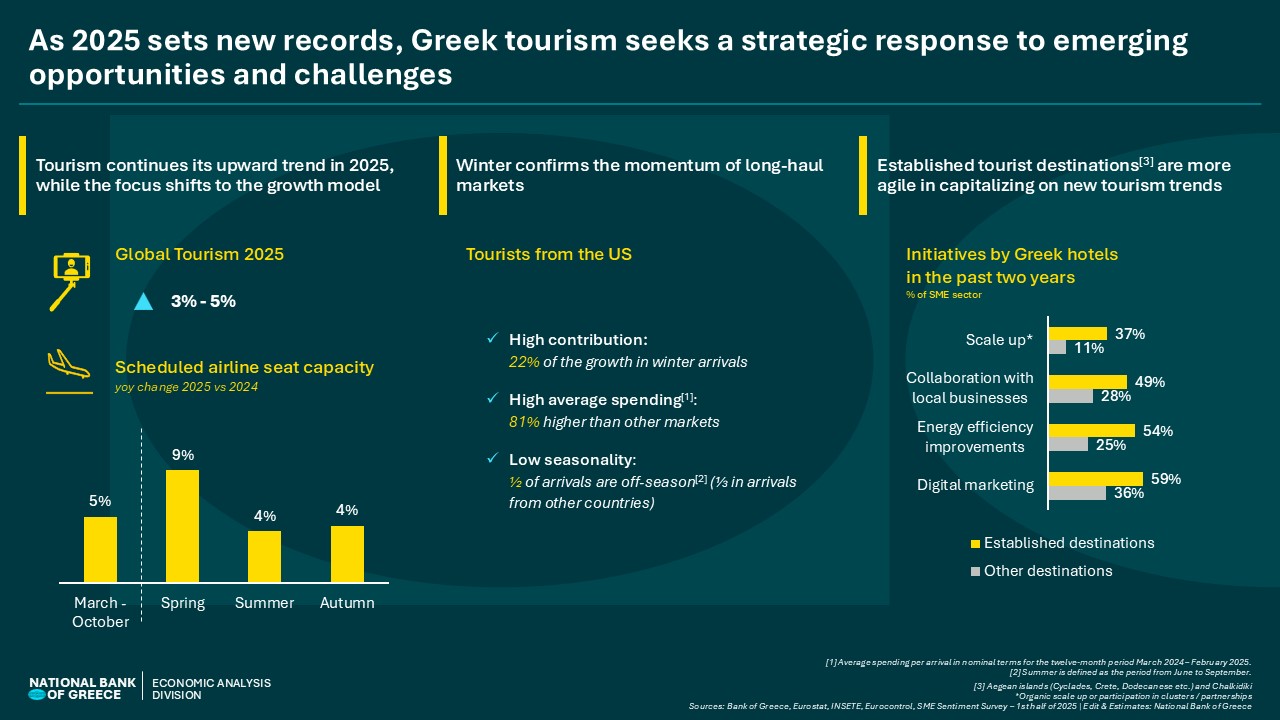Greek tourism remains on an upward trajectory in 2025, with estimates converging to an increase in arrivals of c. 3%-5%, in line with global trends. This outlook is supported by (i) air travel indicators (+10% in arrivals during the first four months and +4% in scheduled airline seats for May–October), and (ii) hotel expectations (SMEs in the sector estimate a 5% increase in arrivals in 2025 based on a National Bank of Greece survey). However, these expectations come with considerable uncertainty, as global geopolitical and economic developments significantly influence consumer willingness to spend on travel (indicatively, the consumer confidence index in key European markets is 5 points below the long-term average).
Following substantial growth from 2013 to 2024 (+63% in arrivals), attention has shifted from record-breaking performance to the underlying development model. Accordingly, our analysis focuses on two key pillars that will shape a sustainable growth strategy (i) source markets, and (ii) destinations.
Regarding source markets, long-haul tourism is expected to play a key role in the sector’s medium-term momentum, contributing ½ of the increase in global tourism over the next decade (as highlighted in a previous study). In this context, attracting long-haul travellers will allow Greece to transition to a new tourism model characterized by lower seasonality and higher average spending. Early signs of this shift are evident in winter season performance, with the US gaining market share (7% of arrivals in 2025, up from 6% in 2024) and simultaneously outperforming in terms of spending per arrival (double that of other markets) and seasonality (½ of arrivals outside the summer period, versus ⅓ for other markets). This trend is further supported by the expansion of direct air connections with the U.S. market (reaching almost 100 flights/week in summer 2025, almost double than those in pre-pandemic period) and China (reaching almost 12 flights/week in summer 2025, almost triple than those in pre-pandemic period).
At the destination level, using findings from our regular survey of Greek hotels, it is evident that “established” tourist areas follow an effective and coherent strategy with a dual focus on (i) competitiveness, and (ii) adaptation to new trends. More than ⅔ of these destinations have made investments over the past three years, mainly targeting scale up (either by organic growth or through partnerships). At the same time, they have largely aligned their overall strategies with the new global demand trends, with around half undertaking initiatives in digitalization, energy upgrades, and promotion of local experiences and products.
In contrast, hotels in the rest of the country appear less responsive across these dimensions, with their capacity being around ⅓ that of established destinations in terms of growth strategies, and about ½ in terms of adaptation to travellers’ new preferences. Since emerging global trends align well with the “new and alternative” offerings of lesser-known Greek destinations, adopting a more growth-oriented and targeted strategy (modelled on established areas) could enable these regions to capture substantial benefits from the new wave of tourism, while also helping the country achieve a more balanced tourism development.
See the infographic:
